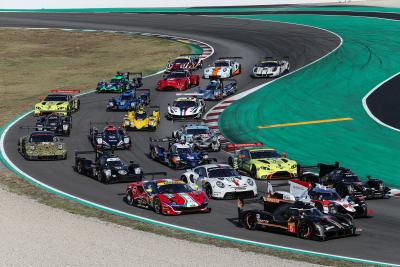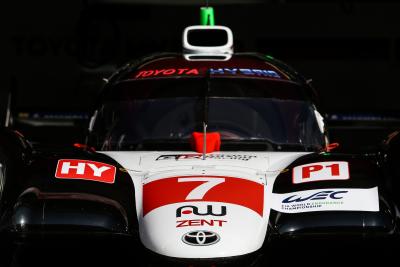FIA WEC Season Preview: Plenty To Fight For
The FIA World Endurance Championship has undergone a huge amount of change in the past two years. Since the culmination of the 2017 season and the end of the intra-manufacturer fight in LMP1 following Porsche’s departure, the series was left looking for ways to adjust and reinvent itself for the future.
Confirmation of what that future will look like – a Hypercar-led top class with at least two major manufacturers in the form of Toyota and Aston Martin – arrived at the 24 Hours of Le Mans in June, with the introduction of the new regulations coming for the 2020-21 season.
The FIA World Endurance Championship has undergone a huge amount of change in the past two years. Since the culmination of the 2017 season and the end of the intra-manufacturer fight in LMP1 following Porsche’s departure, the series was left looking for ways to adjust and reinvent itself for the future.
Confirmation of what that future will look like – a Hypercar-led top class with at least two major manufacturers in the form of Toyota and Aston Martin – arrived at the 24 Hours of Le Mans in June, with the introduction of the new regulations coming for the 2020-21 season.
But where does that leave things for the 2019-20 campaign, starting at Silverstone on Sunday?
Following notable changes across all four classes, and in the very format of the race calendar, the new WEC season still has plenty of big storylines in its corner.
Here’s a look at five things to watch for through the 2019-20 FIA World Endurance Championship season.
1. LIFE AFTER ALONSO FOR TOYOTA IN LMP1
The arrival of two-time Formula 1 world champion Fernando Alonso came at the perfect time for the WEC. The Spaniard helped stimulate plenty of additional interest in the championship for the 2018-19 season as he linked up with Sebastien Buemi and Kazuki Nakajima in the #8 Toyota TS050 Hybrid.
Alonso achieved what he set out to do, winning Le Mans – twice, just for good measure – to tick another box in his triple crown checklist, as well as claiming the drivers’ title alongside Buemi and Nakajima.
But Alonso’s presence was not without its drawbacks. Tensions grew within Toyota’s WEC team towards the end of the season, with Alonso departing its line-up in order to pursue other interest in motorsport. His recent Dakar tests point clearly to where his next stop will be.
So the new WEC season marks a return to normality for Toyota. Alonso’s place in its line-up has been taken by Brendon Hartley, a two-time WEC world champion with Porsche’s LMP1 squad. Hartley returns to the WEC after one season away, spent racing in F1 with Toro Rosso and, since his exit from that programme, completing simulator duties with Ferrari. He also remains a Porsche factory driver, and will be racing for Dragon in Formula E this season. He’s keeping busy.
Hartley will act as a known quantity within Toyota’s #8 crew that is likely to once again find itself racing only the sister #7 Toyota – again featuring Mike Conway, Jose Maria Lopez and Kamui Kobayashi – for top honours.
Equivalance of Technology moves will continue to try and draw the privateer LMP1 runners closer, but they too are reduced this year. Rebellion Racing had planned to enter just one car to the full season, but will expand to a two-car entry for Silverstone. SMP Racing has ended its involvement in the category after just one year. Ginetta returns with an in-house programme following the struggles faced by the CEFC Manor setup in 2018, but its two-car effort may take time to get up to speed.
As glorious as the LMP1 category has been, it will come to a close without much real competition this year. That said, as we saw at Le Mans in 2019, the Toyota vs. Toyota fight can still be a tense and intriguing one.
2. FAMILIAR NAMES BOLSTER LMP2
While numbers may be cut in LMP1, LMP2 will in fact see a growth to eight cars entries for the new season with the addition of some names familiar from the European Le Mans Series and Le Mans.
United Autosports will embark on its first full-season entry to the WEC after regularly appearing at Le Mans in recent years, making the switch to the Oreca 07 Gibson in a bid to be more competitive than it has been with the Dallara in recent years.
United isn’t the only squad making that switch. Racing Team Nederland will also run an Oreca chassis for its second full season in the WEC, meaning the only squad running an alternative is Cetilar Racing, which will run a Dallara P217.
Cetilar joins Cool Racing and High Class Racing in entering the WEC for a full season for the first time, while Jota Sport will now run its own entry solo, having previously operated one car for Jackie Chan DC Racing.
As is often the case in a class running spec chassis, LMP2 promises to be a close one again through ’19-20.
3. THE JOY OF SIX FOR GTE-PRO?
GTE-Pro’s rollercoaster affinity with manufacturers continues for the 2019-20 season. After the full factory return of Porsche for 2017 and BMW’s entry for the 2018-19 campaign, the class will drop back down to three manufacturers for the new season.
Ford’s departure had been expected for some time, with its focus shifting towards the future plans for DPi in the United States, but the exit of BMW was more abrupt when it was announced back in May. Regardless, the long and short of it means we’re back down to six cars for the new season.
Will that deprive us of some of the bonkers wheel-to-wheel fights we’ve seen in GTE-Pro over the last couple of years with eight or 10 cars in the field? Don’t count on it. Ferrari (via AF Corse), Aston Martin and Porsche all have tasted success in the class over the last year, and all will want to continue to prove their prowess heading into the new season, even if they’re up against a lighter field.
Balance of Performance remains a point of contention on occasion, but it typically swings back and forth across the course of a year.
4. GTE-AM’S EXPANSION BODES WELL
In a similar story to the prototype classes, while the factory-led category in GTs contends with a fall in interest, the pro-am one is enjoying a boom. There will be 11 cars on the GTE-Am grid this season – up from nine last year – with some noteworthy changes.
Reigning champion team Team Project 1 expands to a two-car entry for this season, linking up with Keating Motorsports founder Ben Keating after his bid to get a privateer Ford GT on the grid fell short. Ferrari squad AF Corse returns to the class, also with a two-car effort, while there are additional Ferrari entries through Red River Sport and MR Racing.
Porsche will be well-represented once again through Team Project 1, Dempsey-Proton Racing (also entering two cars) and Gulf Racing, while Aston Martin Racing continues with its in-house team, albeit with a tweaked line-up as Ross Gunn and Darren Turner join Paul Dalla Lana in the #98 car. TF Sport will also run an Aston Martin yet again this year, sporting a Deadpool-esque livery that is surely one of the best on the grid.
5. CALENDAR RETURNS TO NORMAL
A lot of compromises were made for the 2018-19 WEC season as the series entered its own ‘limp home’ mode, with one of the biggest coming in the calendar.
While it finally achieved the long-held ambition for WEC and ACO officials to make Le Mans the season finale, it also required the season being 13 months long, and repeating two races (Spa and Le Mans).
But things get back to normal this season. While it remains only eight races, the ’19-20 schedule features eight different circuits and avoids some of the massive gaps that were seen in last year’s calendar.
Silverstone once again acts as the season-opener before the Asian swing to Fuji and Shanghai in the autumn, while Bahrain returns to the schedule nearly two years after its last race. Taking place on December 14, it will continue the Bahrain International Circuit’s tradition for a big sportscar celebration with which to end the year.
Another old favourite returning to the calendar is Interlagos, which last hosted WEC in 2014 before taking a break so it could focus on its renovations. Running on February 1, it means we have a seven-week winter instead of the four-month one of 2018-19.
Sebring returns for another double dip alongside IMSA in March before Spa and Le Mans round out the season. Spa comes forward one week from its regular slot in order to avoid clashing with Formula E (although the issue remains for Bahrain and Sebring), and Le Mans is in mid-June as is tradition.
Arguably the biggest calendar change for ’19-20 comes in the race lengths. After a first diversion from the traditional six-hour race lengths at Sebring last year, WEC has now shaken things up further by offering a mix of four, six and eight-hour races for the new season in a bid to give each race a stronger individual identity. Typically races taking place on Sundays will be four hours, giving fans more time to get home before work on Monday, with Silverstone the first to put that to the test.
Shanghai will also be a four-hour event, while Bahrain will run to eight hours in December. Fuji, Sao Paulo and Spa remain at six, with Sebring again set to be a 1,000 mile event that will take around eight hours.
FIA World Endurance Championship 2019-20 Calendar
1. 4 Hours of Silverstone – September 1
2. 6 Hours of Fuji – October 6
3. 4 Hours of Shanghai – November 10
4. 8 Hours of Bahrain – December 14
5. 6 Hours of Sao Paulo – February 1
6. 1,000 Miles of Sebring – March 20
7. 6 Hours of Spa-Francorchamps – April 25
8. 24 Hours of Le Mans – 13-14 June



![Johann Zarco, LCR, Honda RC213V, 2024 San Marino MotoGP, Misano, action [Gold & Goose]](https://cdn.crash.net/styles/thumbnail/s3/2024-09/GnG_1166323_HiRes.jpg?itok=vpgrU7Q4)

![Jack Miller, KTM Factory Racing, KTM RC16, San Marino MotoGP, Misano, action [Gold & Goose]](https://cdn.crash.net/styles/thumbnail/s3/2024-09/GnG_1167624_HiRes.jpg?itok=iz7mA4EQ)


![Fabio Quartararo, Monster Energy Yamaha Racing, Yamaha M1, 2024 MotoGP, Misano Test, action [Gold & Goose]](https://cdn.crash.net/styles/thumbnail/s3/2024-09/GnG_1168928_HiRes.jpg?itok=fcYSole_)
![Toprak Razgatlioglu, ROKiT BMW Motorrad, BMW M 1000 RR, Magny-Cours, WorldSBK [Gold & Goose]](https://cdn.crash.net/styles/thumbnail/s3/2024-09/GnG_1165133_HiRes.jpg?itok=GD5SVNVG)

